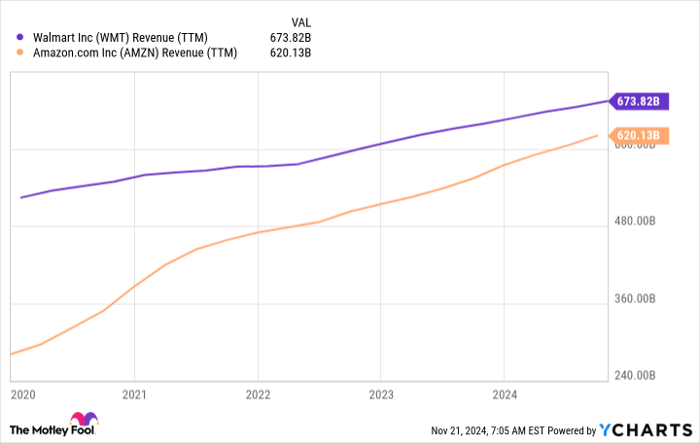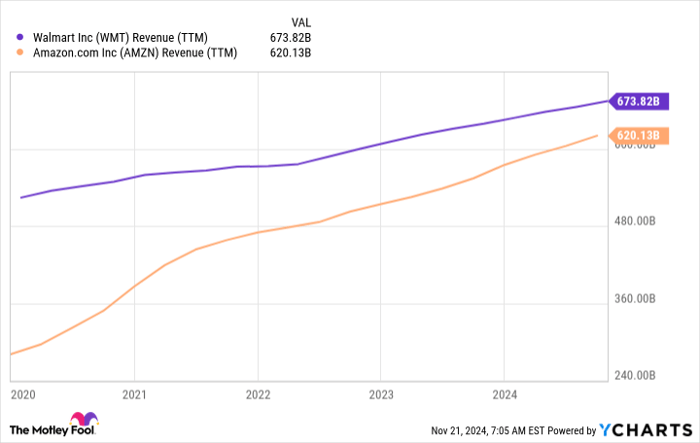Walmart (NYSE: WMT) may be the largest company in the U.S. by sales, but it keeps making its top line bigger. For a while, it looked like competitor Amazon (NASDAQ: AMZN) was poised to overtake it, but Walmart is just too big and doing too well to catch. It’s a battle of true titans, as both companies boast more than $600 billion in revenues over the last four quarters.
Walmart delivered another outstanding quarterly report last week, and the growth drivers behind the results might surprise you. Two factors helping it along are e-commerce growth and an improving ability to attract higher-income customers — areas that have not historically been among its strong points. But Walmart has been making strategic changes in its e-commerce business, and it’s taking off. Can Walmart flip its business and challenge Amazon in e-commerce?
Late to the e-commerce party
Walmart was late to the e-commerce boom, so it missed out on some early opportunities to dominate it. As the largest retailer in the U.S., it could have had an edge. However, it has been developing a strong e-commerce business over the past few years. It was already well positioned when the pandemic struck and customers switched to online shopping, and although it’s way behind Amazon, it’s still in second place.
In its fiscal 2025 third quarter, which ended Oct. 31, total sales were up 5.5% year over year, but e-commerce sales were up 27%. In the U.S., sales were up 5.3% while e-commerce sales were up 22%. Management called out several growth drivers in the report: in-store order fulfillment, in-store pickup, advertising, and marketplace.
In its international segment, e-commerce revenues increased 43% year over year, driven by in-store order fulfillment, in-store pickup, and marketplace. Meanwhile, for its Sam’s Club subsidiary — a warehouse membership chain similar to Costco Wholesale — e-commerce sales increased 26%, a gain notably powered by in-store order fulfillment and pickup.
Management attributed much of that performance improvement to its growing ability to attract higher-income customers through strategies such as expanding its product lines in areas that appeal to them. It said that population accounted for 75% of Walmart’s market share gains in the quarter.
Walmart’s e-commerce business isn’t profitable yet, but it has the money to keep scaling it until it is — and management is confident that it will get there.
Stacking up against Amazon
Walmart’s e-commerce growth might be outpacing Amazon’s. Although the metrics might not be directly comparable, Amazon’s net sales from its online stores increased by 7% in the third quarter, while revenues from third-party sellers increased 10% and advertising sales increased by 19%.
Walmart isn’t likely to catch up to Amazon in online sales anytime soon. Last year, Amazon was responsible for 37.6% of U.S. e-commerce sales, while Walmart’s share was just 6.4%, according to a Statista report. But it could be capturing more market share, and at Walmart’s level, the dollar amount is huge.
With its network of more than 4,600 stores in the U.S., Walmart has some edges over Amazon. Amazon can’t offer the same in-store pickup options and other omnichannel benefits that physical retailers like Walmart provide. That may not be enough to outweigh the edges Amazon derives from its logistics network or its Prime membership program, but it ensures that Walmart will keep a certain share of e-commerce sales from shoppers who prefer the benefits of physical stores.
Walmart is still a much larger company than Amazon, and instead of losing market share, it looks like it’s gaining. I have hypothesized for a while that Amazon is going to overtake Walmart, but although the gap is still closing, (mostly due to Amazon’s non-e-commerce segments), it’s taking a lot longer than I thought it would. With its strong e-commerce business, Walmart might fend off Amazon even longer.
WMT Revenue (TTM) data by YCharts
Is Walmart stock a buy?
Walmart’s phenomenal results were reported at the same time as competitor Target, which had a completely different experience over the same time period. Its e-commerce division is growing faster than Amazon, Target, and Costco.
But while Walmart stock has been looking more attractive lately, it’s not cheap. It trades at a P/E ratio of 36, which is higher than its five-year average of 31.
This may not be the best time to buy. However, Walmart is a long-term play, and it also pays a reliably growing dividend. This all-weather stock is beating the market this year, up 67%. That’s better than many growth stocks. You could buy it at any time and accrue steady gains over many years.
Should you invest $1,000 in Walmart right now?
Before you buy stock in Walmart, consider this:
The Motley Fool Stock Advisor analyst team just identified what they believe are the 10 best stocks for investors to buy now… and Walmart wasn’t one of them. The 10 stocks that made the cut could produce monster returns in the coming years.
Consider when Nvidia made this list on April 15, 2005… if you invested $1,000 at the time of our recommendation, you’d have $869,885!*
Stock Advisor provides investors with an easy-to-follow blueprint for success, including guidance on building a portfolio, regular updates from analysts, and two new stock picks each month. The Stock Advisor service has more than quadrupled the return of S&P 500 since 2002*.
*Stock Advisor returns as of November 18, 2024
John Mackey, former CEO of Whole Foods Market, an Amazon subsidiary, is a member of The Motley Fool’s board of directors. Jennifer Saibil has no position in any of the stocks mentioned. The Motley Fool has positions in and recommends Amazon, Costco Wholesale, Target, and Walmart. The Motley Fool has a disclosure policy.


